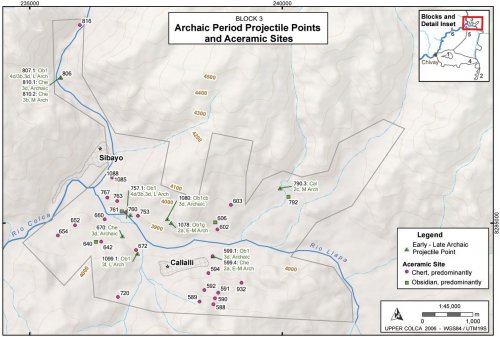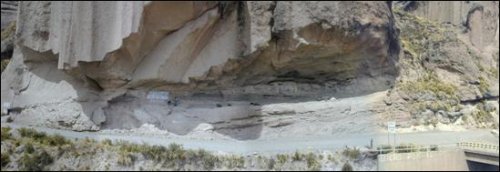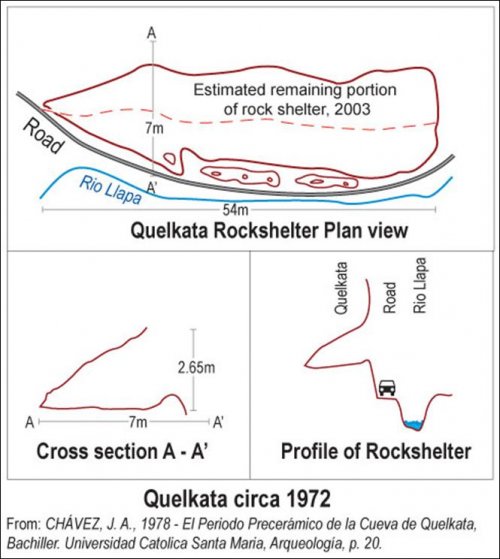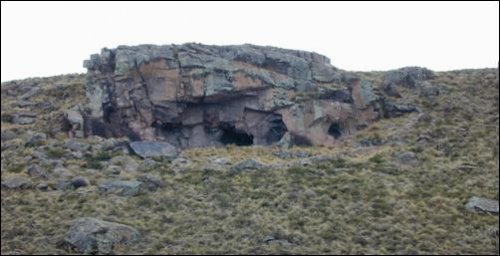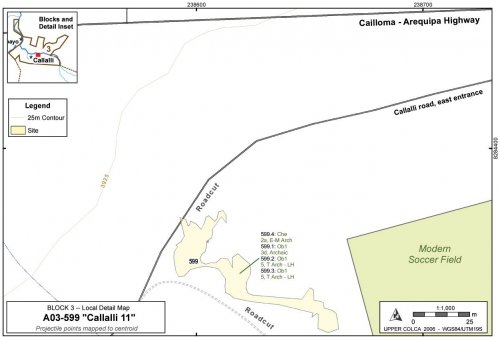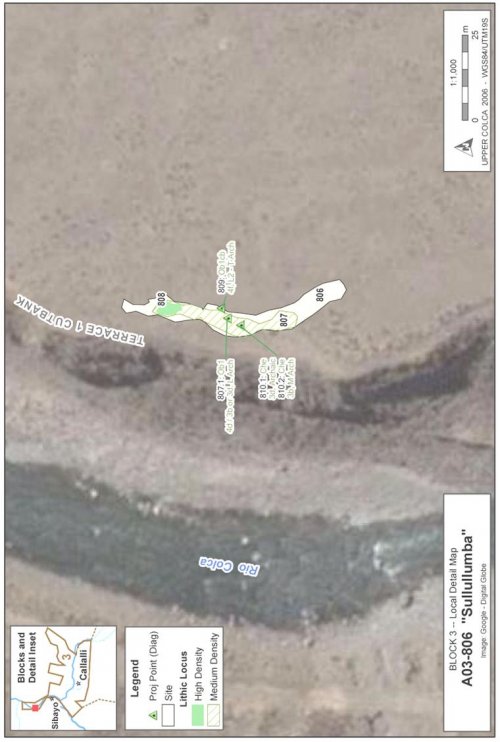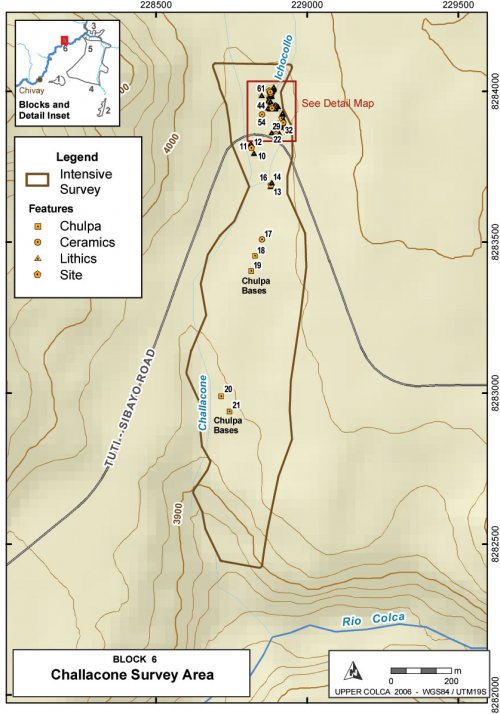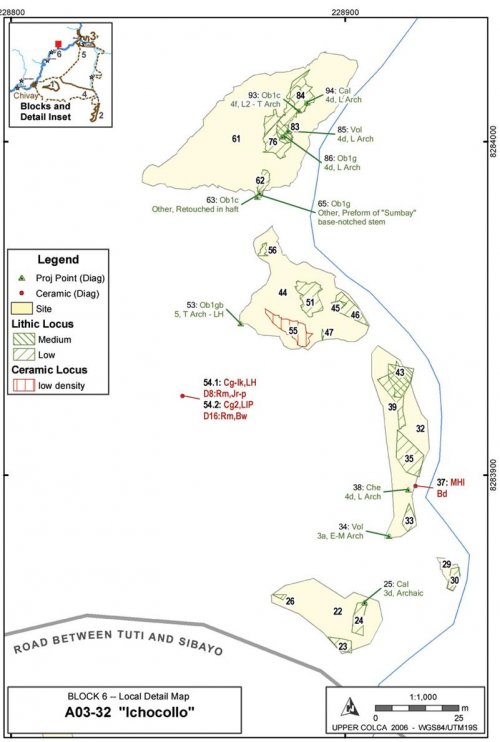Block 3 Archaic Foragers Archaic Settlement Pattern
Archaic Foragers sites in the B3 portion of the survey can be grouped into three categories of sites. For Archaic sites these categories generally correspond with socio-economic activity and lithic provisioning, as indicated by lithics observed during fieldwork and representative grab samples collected from the surface. The three categories of sites include: (1) large, sheltered base camps; (2) small logistical camps, and (3) chert provisioning and initial reduction locations along river banks. These three groups will be discussed, along with the specific characteristics of major sites in each group, and subsequently the isolated or uncategorized sites will be described.
Figure 6-24. Archaic Period in Blocks 3, 6 and 5 (valley): Sites described in the text.
Figure 6-25. Block 3: Early, Middle, and Late Archaic projectile points and Aceramic sites.
A number of aceramic sites were difficult to differentiate from ceramic period sites and thus an comprehensive map, showing all of the potentially pre-pastoral sites, is depicted in Figure 6-25. Inclusively, this group includes most aceramic sites and locations with projectile points diagnostic to the Early, Middle, or Late Archaic Periods.
Site Type: Sheltered base camp
A03-1000 "Kakapunku" [A03-1000 - A03-1013]
The site of Kakapunku [A03-1000] (a.k.a. C'oponeta) is located on the south side of the Río Llapa on a north facing bluff just upstream of the confluence of the Río Llapa and the Río Pulpera. This site consists of three rock shelters spaced about 15m apart along the base of a 10m high irregular cliff band that lies approximately 30m up the hill and south of the high-water line on the Río Llapa. There is a colluvial ramp below the rock shelters and on a terrace below that ramp lie number of lithic loci and some ceramics. The rock shelters are generally north facing so that they are oriented to the mid-day sun and the shelters are warm and well-lit.
|
ArchID |
SiteID |
FileType |
Description |
Area (m2) |
|
1000 |
1000 |
Site_a |
"Kakapunku" |
3400.0 |
|
1004 |
1000 |
Lithic_a |
High Dens, ~70 Obs |
1771.3 |
|
1010 |
1000 |
Lithic_a |
High Dens, ~70 Obs |
76.7 |
|
1013 |
1000 |
Lithic_a |
Medium Dens, ~70 Obs |
148.6 |
Table 6-35. Loci in Kakapunku [A03-1000].
|
ArchID |
Description |
Height |
Depth |
Width |
Width Entrance |
|
A03-1001 |
Mortuary, looted. MNI=7 |
1.6 |
3.2 |
5.2 |
1.9 |
|
A03-1002 |
Domestic, warm rock shelter |
4 |
3.5 |
6 |
5.1 |
|
A03-1003 |
Mortuary, looted. MNI=14 |
1.6 |
~8 |
1.4 |
1 |
Table 6-36. Rock shelters at Kakapunku [A3-1000], dimensions in meters.
Figure 6-26. Site of Kakapunku [A03-1000].
A03-1001 -East rock shelter at Kakapunku
This is a looted mortuary context. The rock shelter is moderately difficult to access on a cliff face, and the entrance appears to have been formerly walled off. The original rock shelter height is difficult to determine because cist tombs in the floor of rock shelter have been excavated by looters. A number of complete crania and long-bones were present. The crania and long bones were examined in the field by Mirza del Castillo, a team member who is a physical anthropologist. From her in-field visual assessment she cautiously suggests that a number of the crania had female metric proportions, and that a number of the crania appeared to have hypoplasia of the bone marrow on the posterior edge of the parietal bones which is a possible indicator of anemia.
Figure 6-27. The entrance of A03-1001 with looted cist tomb visible inside the rock shelter.
A03-1002 - Center rock shelter at Kakapunku
This rock shelter is relatively shallow but other characteristics made it appear to be to be an inviting residential location for a small group of foragers or pastoralists. The shelter is dry inside the dripline, north facing, flat interior, defensible, a short distance from water, and immediately south of a terrace for open-air activities where loci a03-1004 through 1013 are located.
A03-1003 - West rock shelter at Kakapunku
This rock shelter is a lava tube sloping upwards into the cliff face. It appears to contain many disturbed interments. Undisturbed human remains perhaps exist here but they were not visible on the surface.
Discussion
Kakapunku is another case of a multicomponent site where discerning the Archaic component is difficult. Five projectile points were identified belonging to different Archaic Periods, and combined with the ceramics (described later), there is a some affiliation with virtually all time periods at this site.
|
ArchID |
Index |
Material Type |
Form |
Type |
Temporal |
|
1001 |
1 |
Obsidian |
Proj Point |
3a |
Early-Middle Archaic |
|
1002 |
1 |
Obsidian |
Proj Point |
2b |
Latter part of Middle Archaic |
|
1004 |
1 |
Obsidian |
Biface |
n/a |
|
|
1004 |
2 |
Obsidian |
Biface |
n/a |
|
|
1004 |
3 |
Obsidian |
Proj Point Broken |
5 |
Late |
|
1005 |
1 |
Volcanics |
Core |
n/a |
|
|
1007 |
1 |
Obsidian |
Proj Point |
3b |
Middle Archaic |
|
1008 |
1 |
Volcanics |
Proj Point |
4d |
Late Archaic |
|
1009 |
1 |
Obsidian |
Preform |
5a |
Late |
|
1010 |
1 |
Obsidian |
Proj Point Broken |
5d |
Late |
Table 6-37. Selected Lithics from Kakapunku [A03-1000].
On the terrace below the rock shelter [A03-1002] the largest concentration of artifacts were noted. Samples collected from the medium and high density lithic loci on the terrace are approximately 50% obsidian materials with the non-obsidian primarily consisting of aphanitic volcanic stone. The northern high density locus, A03-1010, is eroding down the cutbank caused by erosion and it is possible that this terrace was significantly larger but has been truncated by fluvial erosion of the terrace. In sum, Kakapunku appears to have served as a regular residential area with three relatively small rock shelters.
A03-985 "Quelkata"
This rock shelter lies just below the confluence of the Río Llapa and Río Pulpera along a sweeping bend in the river channel where the Río Llapa first approaches the Castillo de Callalli formation. This rock shelter is well situated and probably served as a residential base through most of prehistory, however surface collections by Jose-Antonio Chávez Chávez (1978) for his Bachelor's thesis revealed primarily preceramic occupation levels with late, Series 5 projectile points. By the time Chavez was able to systematically investigate the materials in the rock shelter it had been largely destroyed in 1976 by the road construction crews associated with the Majes Project (Chávez 1978: 3). The rock shelter was dynamited because it is unfortunately located precisely at a point of the Río Llapa where the project planned to build a bridge on the road to the Condoroma reservoir. What remains today of the rock shelter is a concavity in the tuff with a shelter dry zone measuring approximately 150m wide inside the dripline. Chávez systematically collected and analyzed projectile points from this rock shelter but, curiously, the artifactual evidence available shows an occupation sequence going only as far back as the Terminal Archaic.
Figure 6-28. Cueva de Quelkata was dynamited by Majes Project road crews in 1976. Two people are visible for scale inside the shelter to the left of center.
Figure 6-29. Quelkata in 1975 redrawn from Chavez (1978: 20). Red dotted line shows estimated border of the portion of the rock shelter that remains after the dynamiting for road widening.
Description
The rock shelter was significantly larger in the recent past. Chavez (1978: 20-21) estimates that the dry portion of the rock shelter was 7m deep, 50m wide, and 2.65m high at the mouth. The sheltered area amounted to a 365 m2area with the bulk of cultural debris concentrated in the south portion of the rock shelter. Chávez estimated that the stratigraphy included up to 3m of cultural material. During the 2003 season a great abundance of cultural material was not observed in the slopewash between the highway and the river, as one might expect if the highway were constructed on such quantities of cultural fill, but the area has been much disturbed in recent years.
Figure 6-30. Quickbird satellite image of Quelkata area in 2005. The shelter is under the tuff outcrops immediately to the left of the bridge. Data courtesy of Google / Digital Globe.
Quelkata is located at a major cross-roads in the local transportation network and it has probably been a significant landmark among people in the Upper Colca since the earliest human occupation of the region. The rock shelter mouth opens east-north-east and deposits still evident in the back of the rock shelter are approximately 5 vertical meters above the river and 2.5 meters above the modern highway. As the rock shelter is on a bend in the river the shelter appears to have been scoured out of the outcrop of welded tuff by the waters of the Río Llapa until the river channel was sufficiently incised that it not longer entered the rock shelter proper. Recently Noble (2003) collected a K-Ar sample from precisely this location and the resulting age of 20.7±0.6 million years indicates that the formation dates to the Early Miocene.
Geographical attributes of this location can be summarized as follows.
(1) Quelkata is a large, sheltered site close perennial to water source that probably provides year-round fishing opportunities.
(2) The east-north-east aspect results in warming by the morning sun.
(3) It is located at major intersection in local travel routes which suggests that many were familiar with the site, but also exposes the occupants to anyone traveling in this portion of the valley.
(4) Summits of the "Castillo de Callalli" tuff outcrops immediately above are defensible and appear to have been fortified during the LIP.
|
Figure 6-31. A 65cm column of cultural deposits still exists at the back of Quelkata at a height of approximately 1.8m above datum (at head height between the gravels and the tuff in photo). |
Preservation of Quelkata
Road crews associated with the Majes Project dynamited the rock shelter in 1976 but this was not the first important disturbance in this high traffic area. Significant impacts on preservation at Quelkata are the following
(1) Although the rock shelter lies approximately 5 meters above the dry season water level of the Río Llapa, the rock shelter has probably been scoured repeatedly by high water in past millennia. Quelkata is located on the outer edge of river bend precisely at a channelized portion of the river where 1000 year or even 100 year floods potentially entered the rock shelter and disturbed the contents.
(2) As noted by Chávez (1978: 17) a road has long existed in this area due to the fact that it is a crossroads location and, as a channelized portion of the river, it probably has had bridges prior to the modern bridge construction. With the mining history in the Cailloma area, a road was likely constructed to connect this ore-rich province with the Sumbay railroad sometime in the early 20thcentury. The dynamiting by the Majes crew was intended to widen the road at the bridge and the intersection, and it significantly impacted the rock shelter. However, the downslope colluvial outwash from the rock shelter, which are frequently deposits of great archaeological interest from a rock shelter, had long been disturbed by road construction and by fluvial erosion prior to the destruction by the Majes crew.
(3) The construction crews dynamited the site in 1976 and largely destroyed the southern portion of the rock shelter, the portion that Chávez (1978) describes as having the deepest deposits. There are still significant deposits at the back of the rock shelter, however. As part of the archaeological reconnaissance of the Llapa valley materials systematically surface collected from the rock shelter as will be described below.
(4) The intersection and bridge at Quelkata was a principal junction in the Arequipa highway network until 2002 when the highway connecting Arequipa with Juliaca was paved. Until the asphalting of the Arequipa-Juliaca highway virtually all of the highway traffic between Arequipa and Cusco passed directly in front of this rock shelter where one of the few restaurants and gas stations along the route was located. Thus, a relatively high number of travelers probably visited the rock shelter and its surroundings while waiting for transportation. Fortunately, the dynamiting of the shelter created a sheer 2 m wall so that a brief segment of 4thclass rock climbing is required to enter the rock shelter, discouraging casual visitors.
There are still cultural deposits in a broad but thin and shallow section at the back of Quelkata. While much of the strata along the back of the rock shelter are disturbed sand and river gravels, a cultural level approximately 60cm deep is found across a swath approximately 40m wide at the back of the rock shelter.
Figure 6-32. Profile of extant deposits at Quelkata shown in terms of relative collection units.
Proveniencing
As GPS cannot function in rock shelters, a collection strategy was devised using a datum inside the rock shelter. First, the shelter area was mapped expediently using tape and compass from a semi-permanent datum established on large rock on the north end of the occupation area near the road cut. Artifacts were surface collected from Quelkata in four horizontal collection units that were given ArchID# 986, 987, 988, and 989 to conform to the horizontal collection strategy throughout the survey. The deposits in the back of the rock shelter occurred on natural shelves and the vertical provenience was retained by collecting these shelves from the top (level 1) to bottom (level 5). The lowest level, the shelter floor, appeared to contain a mixture of materials that had cascaded down from above.
Site Collection
In the 2003 fieldwork season 22 flakes and retouched flakes from the rock shelter were collected. These consisted primarily of chert, chalcedony, and andesite. Of the 22 flakes 10 (45%) were made from obsidian, but these obsidian artifacts amount to only 7% of the flaked stone artifacts by weight. A number of bones and goat horns were among the faunal materials collected from the upper levels of the rock shelter, above the rock ledge. It is possible that the horns were placed in this location to dry out.
Chávez Collection
In his Bachelor's thesis José-Antonio Chávez (1978: 52-70) describes and analyzes surface collections that he conducted shortly after the dynamiting of the cave. Chávez includes photographs and drawings of projectile points that appear to be primarily of Type 5B and 5D forms. Chávez reports that he collected 36 projectile points and that the largest group was the concave base form (n = 17) that are probably Type 5B or Type 5D, diagnostic to the Terminal Archaic through the Late Horizon. Of these concave base forms 15 of them were made from obsidian (88%) and the remaining two were chert. Pressure flaking was noted on 16 of the points (Table 6-38).
|
Obsidian |
Non-obsidian |
Totals |
|
|
Unmodified |
434 |
150 |
584 |
|
Modified |
121 |
57 |
178 |
|
Total |
555 |
207 |
762 |
|
Percent |
72.8% |
27.1% |
100% |
|
P.Pt Base: Convex |
7 |
1 |
8 |
|
P.Pt Base: Flat |
8 |
0 |
8 |
|
P.Pt Base: Concave |
15 |
2 |
17 |
|
Probable Concave Base |
12 |
0 |
12 |
|
Cores |
2 |
3 |
5 |
|
Flakes - cortical |
4 |
12 |
16 |
|
Flakes - noncortical |
141 |
93 |
234 |
|
"Blades" |
57 |
40 |
97 |
|
"Choppers" |
5 |
5 |
Table 6-38. Counts of Material types by Artifact Form from 1977 Quelkata surface collections (Chávez 1978: 50-72).
A relatively large proportion of the points are non-diagnostic using Klink and Aldenderfer's typology. Three points described as "convex base" appear to be type 3D, a style which persists throughout the Archaic. Chávez notes that a large percentage of the artifacts were made of obsidian, although the identification of the Chivay source, 20 km to the south-west and 1000 meters in elevation above Quelkata, would not occur for another 15 years. Chávez attributes the relatively large percentage of obsidian to the many very small flakes of obsidian that were included in his sample. Had his analysis included weight of artifacts, the relative presence of obsidian by weight would have been considerably lower than that of other material types. It is apparent that obsidian was being transported to Quelkata and worked at the rock shelter from one of the Chivay obsidian source exposures in the study region.
Another notable pattern in these data is the lack of non-obsidian projectile points. This pattern is consistent with the predominantly base-notched (and Series 5) nature of this assemblage. However, results from the 2003 fieldwork show that this is anomalous in the region, even for the Terminal Archaic and onwards.
Discussion
Several of the projectile points that were noted on the top level of the rock shelter (in unit A03-988-level I) during a preliminary visit to the shelter in 2001 were gone from the rock shelter by the fall of 2003. The points required more careful study, but unfortunately this did not occur, and it was hoped that the points would have been retrieved during the course of the 2003 fieldwork.
It is notable that, despite the apparent importance of Quelkata in the regional settlement pattern, there were relatively few Archaic projectile points found in this rock shelter. Based on the evidence from Chávez and the 2003 examination of the rock shelter, the only definitive projectile point styles encountered at Quelkata are from the Terminal Archaic and onward. One parsimonious explanation for the lack of earlier projectile point styles is that the location of this rock shelter, only 5 m above the dry season water line, was insufficient to prevent particularly intense flooding during the Terminal Archaic which removed evidence from earlier time periods. Given data encountered at the site, this description of the Quelkata rock shelter perhaps belongs in the Early Agropastoralist discussion rather than the Archaic Foragers section of this dissertation. However, due to the centrality of this rock shelter in the settlement pattern, the shelter was likely a prominent settlement throughout the prehispanic period and thus it was included here.
A02-3 "Mollepunco"
The rock shelter of Mollepunco (aka Mollepunku, Cueva de Pirita) is one of the principal tourist destinations in the Upper Colca area (Cardona Rosas 2002: 143-147;Hostnig 2003: 52;Linares Málaga 1992: 287, 290, 291, 298) and it probably receives visitation by about ten groups of tourists per week during the high season. Formerly known as "Pirita" the shelter was renamed "Mollepunco" by Eloy Lináres Malaga in 1984 (1990;1992). This dry rock shelter at the base of a partly welded tuff outcrop consists of two principal cavities and with flat floors and sloping ceilings, and a dry outdoor activity area. The principal cavity is 7m deep, 4m wide, and 5m tall. The shelter is approximately 100 vertical meters above the Pulpera valley floor and it is adjacent to a small perennial stream. The shelter features pictographs and petroglyphs of camelid, bird, and humanoid figures that Augusto Cardona (2002: 143-147) argues are significant because they show the transition from pictographs to petroglyph techniques, and the art is believed to have been executed by herders and is therefore no older than 3000 BCE. The art has been interpreted as dating to relatively late periods because plump camelid figures are often shown in herds, and one solitary camelid has what appears to be a rope around its neck. The shelter was excavated by Linares (1992) and despite the gate blocking the entrance of one sector, it appears that the shelter was significantly looted. An open burial chamber probably dating to the LIP is evident high in the southern end of the rock shelter.
Figure6-33. Cueva de Mollepunco (A02-3).
Figure 6-34. Petroglyph of camelid on wall of Mollepunco.
Lithic debris is predominantly chert but a significant portion of the flaked material is obsidian. Bone and LIP ceramics are also evident at the site, perhaps resulting, in part, from the looted burial. Given the heavily visited and previously collected nature of this site surface the 2003 Upper Colca project field crew did not attempt a systematic recording of surface artifacts.
A03-1074 "Pokallacta"
This is a small, sheltered site that has evidence of occupations in both the Archaic Foragers period and subsequent times. The site is immediately to the west of a steep tuff outcrop approximately 100m high. The site is in the shadow much of the day, but it is a sheltered location that is protected and yet offers large views of the river valley.
The rock shelters are fronted by a flat area that today is a corral. This flat activity area is mapped as two Structure Loci though they are essentially one terrace. The two loci delimit the artifact spill zone for each respective rock shelter and each structure locus was assigned the same ArchID number as the rock shelter above it.
|
ArchID |
SiteID |
FileType |
Description |
Area (m2) |
|
1074 |
1074 |
Site_a |
"Pokallacta" |
4,342.7 |
|
1075 |
1074 |
Struct_a |
Southwest shelter |
63 |
|
1076 |
1074 |
Struct_a |
Northeast shelter |
45 |
Table 6-39. Loci in Pokallacta [A03-1074].
|
ArchID |
Description |
Height |
Depth |
Width |
Height At Back |
|
1075 |
Residential, pastoral |
2.5 |
9 |
10 |
1.2 |
|
1076 |
Residential |
2.2 |
6 |
5.3 |
0.9 |
Table 6-40. Rock shelters at Pokallacta [A3-1074], dimensions in meters.
|
ArchID |
Index |
Material Type |
Form |
Type |
Temporal |
|
1074 |
1 |
Obsidian |
Proj Point Broken |
5d |
TA - LH |
|
1074 |
2 |
Obsidian |
Biface Broken |
n/a |
|
|
1074 |
3 |
Obsidian |
Proj Point Broken |
5a |
Term Archaic |
|
1074 |
4 |
Volcanics |
Biface Broken |
n/a |
|
|
1075 |
1 |
Chalcedony |
Proj Point |
5 |
TA - LH |
|
1076 |
1 |
Obsidian |
Proj Point |
5b |
TA - MH |
|
1078 |
1 |
Obsidian |
Proj Point |
2a |
Early - Middle Archaic |
|
1080 |
1 |
Obsidian |
Proj Point |
3d |
Archaic |
Table 6-41. Selected Lithics from Pokallacta [A03-1074].
The bifacially flaked items are largely obsidian but notably the bulk of the grab sample of unmodified flakes was of chert and chalcedony. This reflects the location of the site on the north side of the Río Llapa, and is consistent with a raw material use pattern observed elsewhere on the survey.
A03-1075
This rock shelter has a very thick dung cap and it is difficult to see the ground. The slanting roof and open west side provides a large but only partly sheltered area. It appears that a protective wall was constructed on the west side in the past.
A03-1076
This rock shelter is the more protective residential shelter of the two, offering a view of the river valley and the surrounding terraces.
Site Type: Small logistical site / hunting blind
Given the weak evidence of Archaic occupation in the Block 3 area, traces of early logistical sites and hunting blinds were difficult to discern from the well-distributed pastoral period evidence. As described above, archaeological sites were judged to contain pre-pastoral components belonging to logistical sites and hunting blinds when assemblages were of low diversity and long term site occupation evidence was slight. Often such sites are hard to definitely characterize as "archaic logistical sites" because the sites were found in places that appeared to be either predominantly later occupation period, or they were situated in were from ridgelines and other relatively exposed, steep, and waterless locations that were judged to be relatively unsuitable for long-term residential occupation.
A number of sites fall into the category of logistical sites and hunting blinds because it is essentially a catch-all category of potential pre-pastoral behaviors that do not contain definitive evidence for later occupation, such as ceramics. However, during the wet-season herders in the Upper Colca area return to the valleys (Markowitz 1992) and the slopes above the city of Callalli become suitable grazing land. A herder tending the flock high on the slopes might knap stone and create an aceramic site far from pastoral facilities or bofedales. Thus, it is difficult to conclusively say that the Block 3 aceramic sites (shown in Figure 6-25) predate the Terminal Archaic; the aceramic distribution is presented here conditionally.
|
Sitem |
Sites |
Block 3m |
Block 3s |
Block3 m - Sitem |
|
|
Altitude (masl) |
3947.2 |
83.7 |
3984.5 |
87.45 |
+37.3 |
|
Slope (degrees) |
9.8 |
5.5 |
12.3 |
8.5 |
-2.5 |
|
Aspect (degrees) |
SE |
SE |
SW |
SE |
NE |
|
Visibility/Exposure |
38.3 |
24.2 |
39.1 |
23.4 |
+.8 |
|
Dist. to Bofedal (m) |
1420 |
600 |
1024.8 |
567.9 |
-395.2 |
Table 6-42. Environmental characteristics of aceramic sites.
An exploration of the environmental circumstances of these aceramic sites shows that the sites are found in higher altitude areas, relative to the terrain in Block 3, and the distribution are on relatively steep slopes for site locations. The highly variable aspect measure is not particularly informative, though it shows a slight tendency towards south-east exposures in a block that trends to the south-west. These sites are found in relatively exposed, high visibility areas, and they tend to be farther than average from bofedales, though on the whole bofedales are not widespread in Block 3. Examples of such sites would include a few that contain diagnostic pre-pastoral Archaic projectile points, but also appear to contain evidence of later occupations.
A03-599 "Callalli 11"
This site is on the east edge of Callalli just beyond a quebrada. A relatively dense scatter of flaked stone and projectile points from two Archaic styles and two later (Type 5) styles were found here, but the artifacts were not sufficiently dense to merit mapping as a low density lithic locus. The site is heavily disturbed by the construction of two roads on either side of it: the modern Callalli access road to the north and a narrow, steep road accessing the soccer field to the west and south of the site.
Figure 6-35. View westward from "Callalli 11" across quebrada shows the eastern edge of Callalli.
This deflated terrace edge area contained flakes approximately one half chert and one half obsidian by count, and 1/4 of the obsidian was cortical. A ground andesite hammerstone weighing 294 g and stained with ochre was also found here. This open air site area offers partial shelter in the form of the quebrada and associated lower terraces that are now destroyed by road construction. The quebrada probably contained water for part of the year.
Figure 6-36. Callalli 11 [A03-599] on terrace on the east edge of the town ofCallalli.
A03-785 "Anccasuyo"
Another possible logistical site was found away from the principal river channel in the area of the colonial site of Anccasuyo. A single type 1A (Early Archaic) or 2C (Middle Archaic) projectile point of chalcedony, broken at both ends, was found here. The temporal assignment is ambiguous because of the broken base. This location is adjacent to a small tributary to the Río Llapa and where an outcrop of tuff creates a small pool that has been developed into a stock pond.
|
Figure 6-37. Chalcedony projectile point [A03-790] from Anccasuyo [A03-785]. |
There were two obsidian flakes here, and five non-obsidian flakes. While the Archaic evidence from this site is small, a single point (that could have been scavenged from elsewhere by the colonial occupants), if the context is intact it represents a kind of peripheral, hidden habitation that one might expect to complement the larger residential bases elsewhere in the valley.
A03-675 "Taukamayo" (A02-26)
This area meets the criteria for a possible short term camp or logistical camp during the Archaic Foragers period. A red chert foliate projectile point was found just outside of the principal site of Taukamayo, a site that will be discussed in detail below. The chert point is probably type 3D (incomplete scar coverage) and it is of a style that is only diagnostic to the preceramic period. This location is a bench terrace that is relatively exposed topographically but, as with site A03-599 Callalli-11 there are opportunities for shelter nearby. This site is classified here this as a possible logistical camp during the Archaic because the immediate occupation appears relatively small and exposed for a residential base, but the evidence is conflated with quantities of flaked stone and pottery from later occupations. The site is positioned at the base of a principal access trail to the high country to the south, and close to the biggest river confluence in the region. In other words, there is not a lot of evidence of long term occupation or diversity of activities during the pre-pastoralist period at this site, but the location appears to be positioned strategically with respect to local travel corridors and the monitoring of the river confluence, and the site thus appears to have more than merely a chert procurement location.
Site Type: Chert provisioning site
A final site type category to be considered in this section is that of Archaic Period Block 3 provisioning and initial reduction sites. A relatively large number of sites are found on the lower terraces of major watercourses. The sites can be characterized as exposed, open air sites featuring cortical reduction debris where the majority of material is chert or chalcedony, and the tools are discarded bifacial tools and points. The process appears to have consisted of obtaining chert cobbles from the river bed during low water seasons and opening the cobbles in the riverbed to evaluate the knapping quality of the material. Some percentage of cobbles deemed suitable for further reduction were then transported to the terrace above, where knapping occurred. Sites rich in chert were not exclusively encountered on these river bank areas, but these production sites were abundant in cortical material and the mean flake sizes were relatively large.
These kinds of sites were encountered most frequently on the very edges of terraces but this was perhaps due in part to the greater visibility from erosion along the terrace margins. The sites are otherwise exposed and appear to have been an unlikely place for residential occupation. The profiles of cut banks were investigated at some of these sites and stratified deposits were rarely observed eroding from the cutbanks. The 2003 season survey did not encounter chert raw material in its original geological context, it was only found in the bed of streams in the Block 3 area. As a consequence, it appears that most of the chert artifacts recovered during the 2003 season were probably knapped along these river terrace margins, and it is difficult to assign a time period to these early production sites. There was no strong patterning with the temporally diagnostic point styles and the material types used in Block 3 during the Archaic Foragers period. Points were made from chert and obsidian in Block 3 throughout the Archaic and obsidian points were frequently found on river terrace margins surrounded by chert knapping debris.
A03-806: Sullullumba
A good example of a river terrace provisioning site with evidence of multiple Archaic Period occupations is "Sullullumba" [A03-806]. This site was the only site with purely Archaic occupations in Block 3. It is located up the Colca river from the confluence at Sibayo, and is therefore one of the areas furthest in the study area from the Chivay obsidian source. The site is located on a pronounced terrace edge on the inside bank of a broad bend in the Colca river. Under modern conditions, the area is exposed both to valley winds and by the fact that it lies on the edge of a 40 m steep downslope to the annual high water mark in the river channel.
Figure 6-38. Map of the Sullullumba [A03-806], an Archaic Foragers site showing lithic loci on terrace edge 40m above the annual flood line. Image courtsey of Quickbird DG / Google.
Figure 6-39. Sullullumba [A03-806] along terrace edge above the upper Río Colca. Yellow notebook and scale bar are visible in the center-rear of photo.
|
ArchID |
SiteID |
FileType |
Description |
Area (m2) |
|
806 |
806 |
Site_a |
Sullullumba |
366.6 |
|
807 |
806 |
Lithic_a |
Medium Dens, 10 Obs |
169.6 |
|
808 |
806 |
Lithic_a |
High Dens, 10 Obs |
21.3 |
Table 6-43. Loci at Sullullumba [A03-806].
Artifact analysis from Sullullumba
As one of the only single component Archaic Forager sites, seventy-four artifacts collections from this site were given thorough attention in lab analysis. The items below indicate the kind of lithic reduction that occurred on river terraces some distance from the Chivay source.
Obsidian
Obsidian material consisted of two types: clear and clear-banded flakes with no heterogeneities, and grey and black shaded obsidian with heterogeneities. Two broken projectile points and one broken biface were made from obsidian that is presumably of Chivay type material. A single flake of clear obsidian was found highly rotated and with 20% dorsal cortex, placing it at a mid-stage reduction. This obsidian flake was perhaps struck from the biface or the projectile point collected from this site.
Chert and Chalcedony
No pattern was discerned in the color of chert used at Sullullumba, but there was a relatively high percentage of chert and chalcedony in the surface assemblage. From the collection of 74 artifacts from the site, 50% were made of chert or chalcedony. Sixty-five percent of the chert showed signs of heat treating. Interestingly, about half of the chert flakes showed signs of rotation indicating that the potential of chert cores was maximized despite the probable availability of chert in the Colca river. None of the flakes, however, were bifacial thinning flakes and only six flakes had more than 20% cortex. No correlation was noted between (1) the flakes with high rotation index and (2) heat treatment or chert color. Thus, it appears that chert was being procured and preforms were being produced but the final, thinning stages of point production were not occurring at this site or these smaller flakes were not recovered from the surface context.
A number of interesting projectile points were collected here that include a type 4f (Terminal Archaic) point made from clear banded Ob1 obsidian that includes pressure flaking around the haft Figure 6-40. Another point is a likely type 3b (Middle Archaic) point made from red chert with several spines on the haft margin.
Figure 6-40. Projectile points from Sullullumba [A03-806]. These include (a) an obsidian Ob1 4F (Terminal Archaic) point [A03-809.1] and (b) and the base of a probable 3b (Middle Archaic) chert point with shoulder spines [A03-810.2].
Figure 6-41. The high density lithic locus A03-808 consisted of aphanytic volcanics and chert.
Complete flakes from this site show highly variable attributes that result from a complete reduction sequence having occurred in the area. A high density locus of flakes made of fine-grained volcanics, chert flakes, and chert heat-shatter [A03-808] perhaps result from a single knapping event. In sum, this site presents evidence of Archaic Period open-air activities a greater distance away from the influence of the Chivay source.
A03-32 "Ichocollo" site cluster in Block 6
Approximately 10 km down stream from Block 3 a cluster of open-air sites along a tributary to the Colca was encountered in a smaller survey area called block 6. This block contains a large fraction of diagnostic Archaic projectile points along with ceramics and projectile points dating to the later Prehispanic period. In the modern geography of the region Block 6 lies immediately above the portion of the Colca valley with intensive agriculture. The Río Challacone descends from the north-east flanks of the glaciated Nevado Mismi (5556 masl) on the north side of the Colca valley, while the Ichocollo drains the south side of Cerro Chungara (5286 masl), a peak that was probably glaciated on its southern flank approximately in the same period of time as the Chivay obsidian source area contained glaciers.
|
SiteID |
FileType |
Description |
Area (m2) |
|
22 |
Site_a |
"Ichocollo 3" |
400.1 |
|
29 |
Site_a |
"Ichocollo 4" |
36.4 |
|
32 |
Site_a |
"Ichocollo 5" |
527.5 |
|
44 |
Site_a |
"Ichocollo 6" |
729.9 |
|
61 |
Site_a |
"Ichocollo 7" |
1375.5 |
Table 6-44. Site sizes in Ichocollo [A03-32].
This glaciation may have provided steady water to residents along the eastern tributary stream named Ichocollo. Today, the western of the two, the Challacone drainage, appears to be the larger stream channel and is more scoured out (see geology map in Figure 4-15), a feature perhaps related to the geologically recent large mudslide visible in the geology map as "Ladera Tinday" with the Qr-desymbology.
Figure 6-42. Block 6 Challacone - Ichocollo overview map
Figure 6-43. Ichocollo complex along Quebrada Ichocollo.
Artifacts from Ichocollo complex
Several clusters of lithics and ceramics were identified and divided into sites in this confluence area between the two drainages. The greatest density of artifacts were found on the west bank of Quebrada Ichocollo between the two streams, in an area that is relatively low lying compared to other creek banks in the zone. The area was occupied in numerous episodes in prehistory, as is evident in the diagnostic artifacts that belong to styles spanning all time periods from the Early Archaic to the Inka period. There are a number of environmental characteristics that would suggest that this area would be reused frequently in prehistory. On a local scale, the position of these sites between the two creeks perhaps provided the residents with greater opportunities in both water sources and in lithic raw materials, as cobbles occur in the creek beds. In terms of the position of this survey block in the valley, as was noted previously, the Challacone drainage is at nearly 4000 masl but it is geographically only 3 km to the east of Tuti zone that includes the warmer reaches of the Colca valley below 3900 masl and the beginning of intensive agriculture in modern landuse patterns.
A number of chert and chalcedony nodules were observed in the Ichocollo streambed and the chert was predominantly red in color and was a consistent, homogeneous material with moderately good fracture characteristics. The predominantly red-orange chert nodules in the river are evident in material used for the bifacially flaked lithics found in this site cluster, and 30 of these bifacial tools showed signs of heat treating. Relatively few of the artifacts of any material type, including chert, contained exposed cortex. One chert core had 3 rotations, and chert flakes were predominantly in advanced stages of reduction. Obsidian was of both grey and clear varieties and 27% of the obsidian in the collections had heterogeneities.
Figure 6-44. Photo looking northwest across Ichocollo creek in the foreground, the site cluster that includes "Ichocollo" [A03-32], and Challacone creek below the structure in the background.
|
Biface |
Retouched Flake |
Proj Pt |
Core |
Total |
|
|
Obsidian |
14 |
2 |
5 |
21 |
|
|
Volcanics |
3 |
1 |
2 |
6 |
|
|
Chalcedony |
1 |
1 |
3 |
5 |
|
|
Chert |
10 |
5 |
1 |
1 |
17 |
|
Quartzite |
3 |
3 |
|||
|
Total |
31 |
9 |
11 |
1 |
53 |
Table 6-45. Bifacially Flaked Lithics from Ichocollo by Material Type
|
Length (mm) |
Total |
||||||||
|
15-20 |
20-25 |
25-30 |
30-35 |
35-40 |
40-45 |
45-50 |
>50 |
||
|
Obsidian |
4 |
8 |
3 |
3 |
1 |
1 |
20 |
||
|
Volcanics |
1 |
1 |
1 |
3 |
|||||
|
Chalcedony |
1 |
2 |
1 |
1 |
5 |
||||
|
Chert |
1 |
1 |
3 |
3 |
2 |
5 |
15 |
||
|
Quartzite |
2 |
1 |
3 |
||||||
|
Total |
4 |
10 |
5 |
6 |
4 |
7 |
4 |
6 |
46 |
Table 6-46. Bifacial Lithics at Ichocollo showing Counts of Material Types by Length
An examination of lengths of bifacially-flaked artifacts from the Ichocollo area by material type shows that the immediately-available chert and chalcedony materials are found in bifaces in a range of sizes. Together with the lack of high rates of cortex, these data suggest that the Ichocollo site cluster is associated predominantly with middle-stage reduction. Potentially, decortication occurred in or near the stream bed, while middle and more advanced reduction occurred closer to the residential sites.
Block 3 Archaic Period discussion
The evidence reviewed here has shown that the pre-pastoral Archaic occupation of the Block 3 survey area was light and appears to have consisted of many relatively shortterm occupations. The Archaic Forager period in this region perhaps involved passing through through the river valley while traveling between the puna and the lower elevation Colca valley.
Based on this appraisal of modern resource distributions, the Block 3 section of the landscape presents relatively few opportunities for foragers that are not available in greater abundance elsewhere in the region. Hunting opportunities were likely to have been good in the smaller stream channels and atop the transversal lava flows and the tuff outcrops, but the Block 3 area falls between two rich areas that probably had greater natural abundance: the rich, rain-fed grasses of the puna above, and the lower elevation vegetative productivity of the main Colca valley where berries and herbs probably became available. Gathering opportunities may have been more abundant in the lower elevation parts of the Colca valley downstream, while the economic focus in the puna would have been on hunting.
Problems in isolating Early Agropastoralist sites
As was mentioned in the discussion of the pre-pastoralist Archaic occupation of Block 1, nearly all sites of significant size were multicomponent sites, and the difficult in differentiating components by time period is severe. The strongly pastoralist occupation will be described here, as well as the intensification on obsidian procurement in the Maymeja area that appears to have occurred with the onset of pastoral lifeway in the Terminal Archaic. Some of these sites discussed here may, in fact, date to later pastoralist periods but if the site does not have ceramics diagnostic to later periods, then it was not possible to differentiate the later occupation from mere surface artifacts. Architectural remains, such as chulpas, also serve to differentiate some Early Agropastoral from Late Prehispanic (particularly LIP and LH) occupations.
The problems associated with differentiating the Early Agropastoralist component in the study area can be characterized as follows.
(1) Persistence of pastoral economy. Areas with rich pasture have been consistently occupied since the early pastoral period until modern times, and in many cases the pasture has been enlarged through landscape modification such as expanded irrigation to the margins of bofedales.
(2) Projectile points. The projectile point typology proved to be very useful during the earlier Archaic Foragers period, but the typology is largely non-diagnostic to time period from the Terminal Archaic onward (Series 5 types).
(3) Ceramics. Formative Period ceramics are poorly defined in the Arequipa highlands and this limits the ability of archaeologists to differentiate Formative wares from utilitarian wares from later periods. Furthermore, utilitarian wares may be encountered more frequently at remote pastoral bases.
(4) Architecture. The defining features of pastoral settlement in the region, estancias and corrals, are generally not diagnostic to time period. Architectural features specific to the Collagua during the LIP, such as square structures with round corners and tall narrow doorways did become established in the main Colca valley, but the pastoral structures encountered in the course of this research showed no evidence of this kind of architecture.

